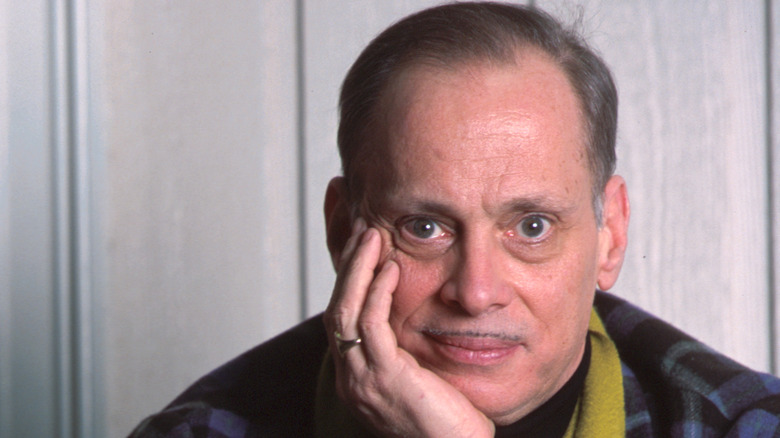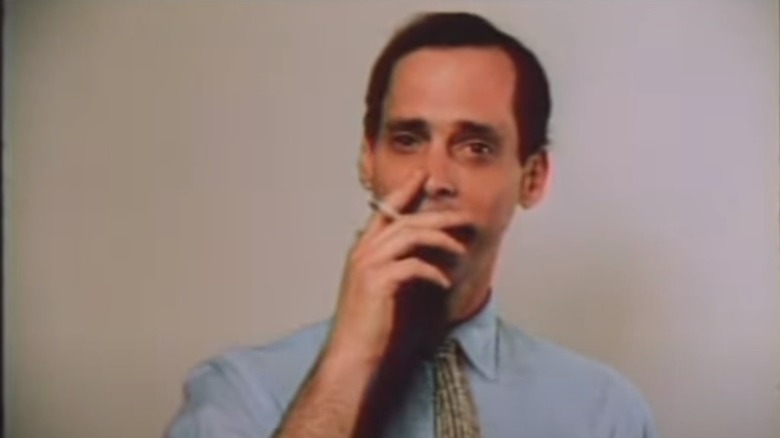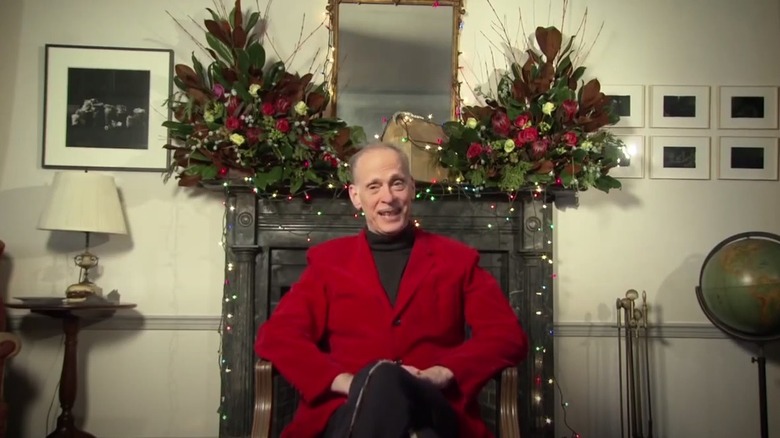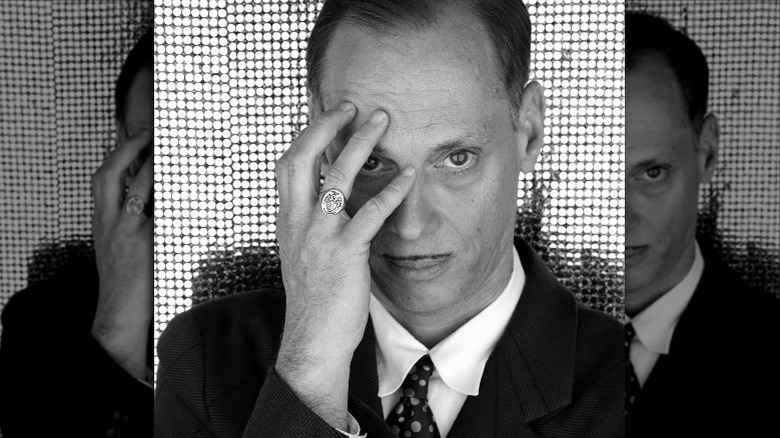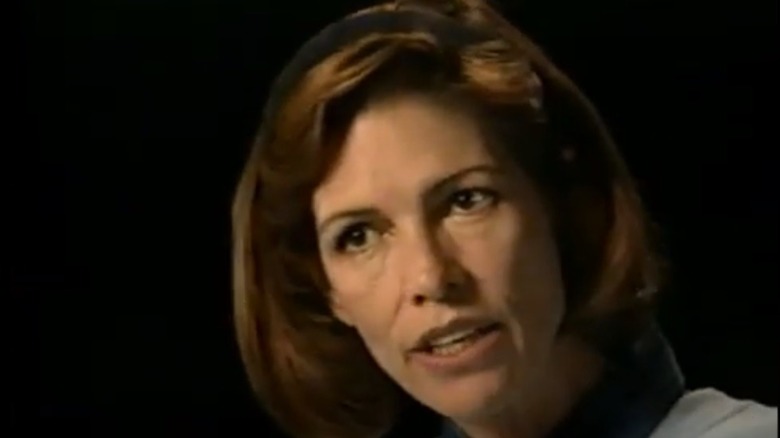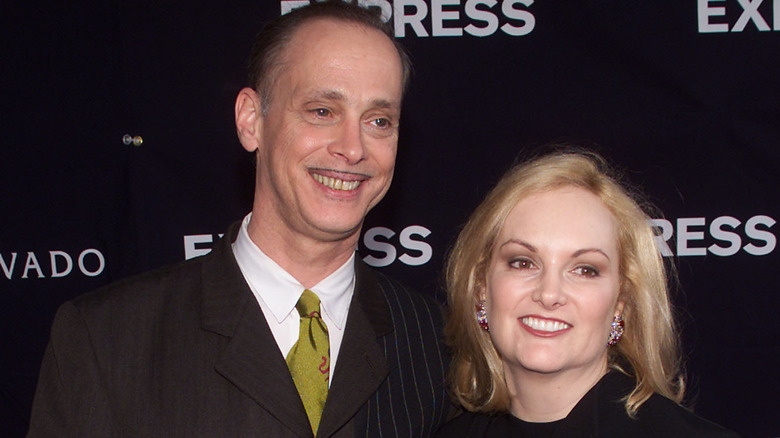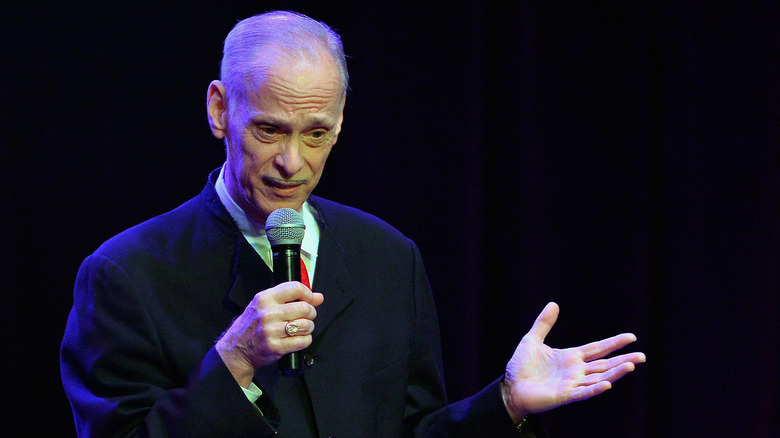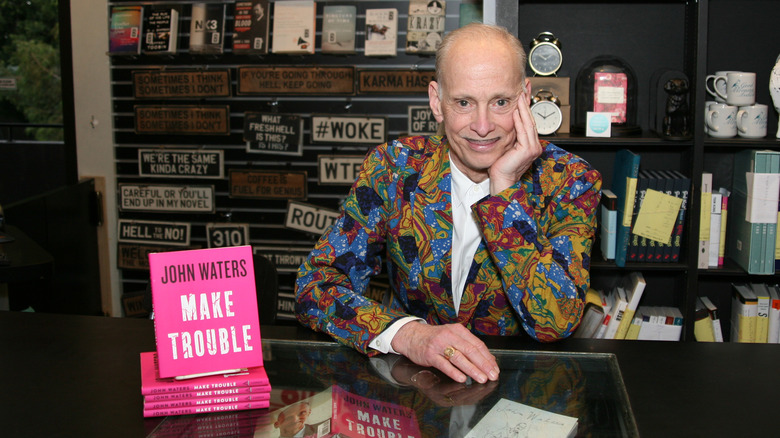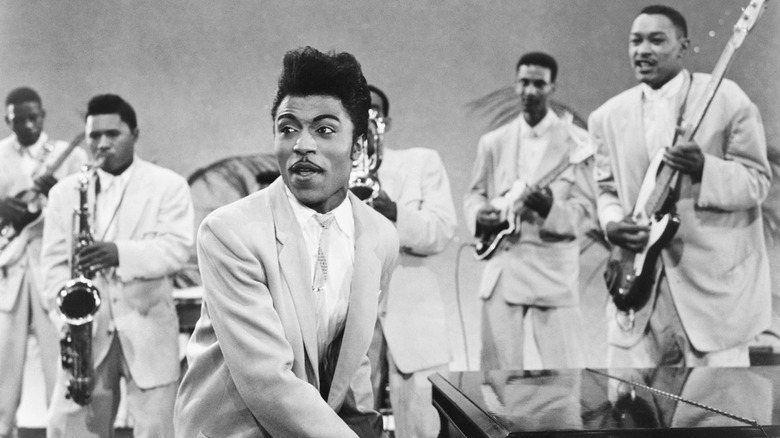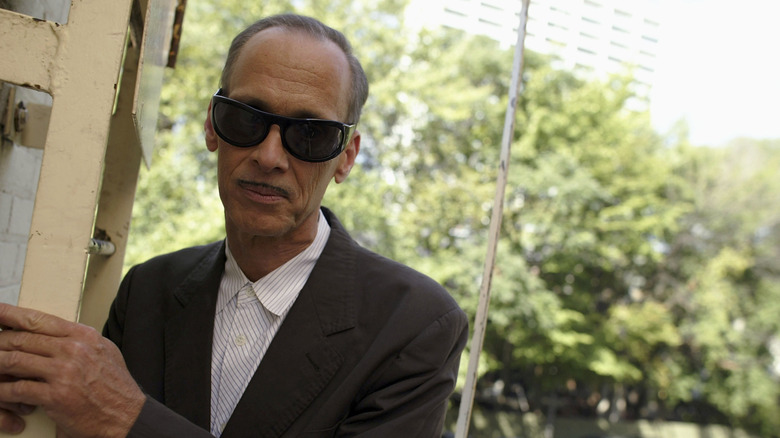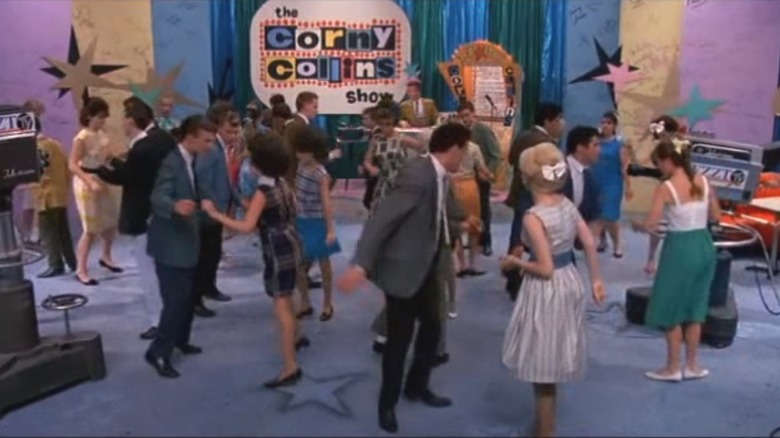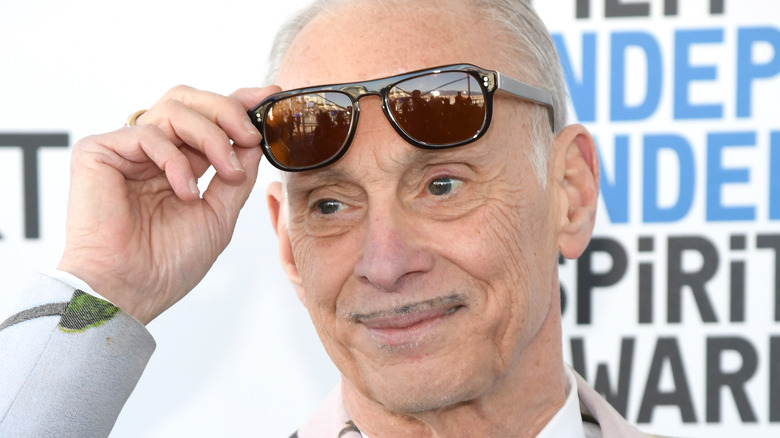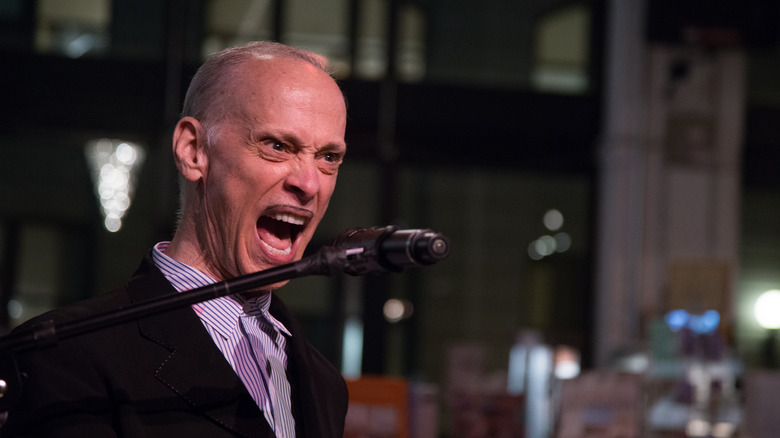The Untold Truth Of John Waters
Over the course of his five-decade career, John Waters has gone from being America's most transgressive underground filmmaker to a beloved pop culture icon. Obsessed with celebrity, gore, and camp, Waters blended bad taste with high art in such films as "Mondo Trasho," "Pink Flamingos," and "Desperate Living." From bizarre fetishes to family dysfunction, no subject was off limits for the Baltimore native and his troupe of creative cohorts known as the Dreamlanders during their rise to infamy in the 1970s.
The following decade would find Waters taking a turn toward the mainstream with the release of 1981's "Polyester," a wickedly subversive send up of 1950s-style "women's pictures." Waters continued his unlikely transition to respectability with 1988's "Hairspray." His most family friendly film to date, "Hairspray" is a funny, and at times, touching, nostalgic trip back to the teen dance scene of 1960s Baltimore that also manages to explore the racial and social politics of the era.
Throughout the 1990s and 2000s, Waters continued making relatively mainstream comedies focused on his skewed obsessions, including the 1990 Johnny Depp vehicle "Cry-Baby" and the 1994 cult favorite "Serial Mom." In 2004, Waters returned to his transgressive roots with the NC-17 rated "A Dirty Shame."
However, Waters is much more than the sum of his low-brow obsessions. A self-described "filth elder," his pointed commentary on life and culture have made him a role model for generations of outsiders. This is the untold truth of John Waters.
John Waters had supportive parents
From the Gravels of "Desperate Living" to "Polyester's" Fishpaw clan, family life in a John Waters' movie is often a hilarious hellscape of dysfunction and depravity. Given the outlandish nature of Waters' art, it seems natural for fans and critics alike to question his own upbringing and family life.
It may come as a surprise, but the most unusual thing about Waters' upbringing was Waters himself. Born in 1946 in Baltimore, Maryland, to parents John Waters Sr. and Pat Waters, John Waters grew up in the suburb of Lutherville. As detailed in John G. Ives' biography, "John Waters," the filmmaker's upbringing was typically upper middle class and Roman Catholic. Still, many of the unusual obsessions that would come to characterize Waters' work developed early.
One of his favorite childhood games was Car Accident, which involved crashing his toy cars together and making up gruesome stories about the people trapped inside. To satiate her son's appetite for the macabre, Pat Waters would often take John to the junkyard to look at the smashed cars. At age 7, Waters' love of "Howdy Doody" and the 1953 film "Lili" led him to take up puppetry. Despite its excessive violence and gore, Waters' puppet show was in constant demand for birthday parties.
As a teen, he developed a taste for the schlocky B horror movies and the art films. On his 17th birthday, Waters received a gift from his grandmother that would change his life: a handheld, 8-mm Brownie movie camera.
John Waters loves Christmas
At first, it may seem out of character for an iconoclast like John Waters to love a warm and fuzzy holiday like Christmas. Nevertheless, Baltimore's pope of trash is mad for the Yuletide and all the tawdry commercialism and uncomfortable family moments that go along with it. In an essay titled "Why I Love Christmas" from his 1986 book "Crackpot" Waters writes, "In July I'm already worried that there are only 146 shopping days left. ... As each month follows, I grow more and more obsessed. ... November 1st kicks off the jubilee of consumerism, and I'm so riddled with the holiday season that the mere mention of a stocking stuffer sexually arouses me."
Of course, Waters' favorite childhood memory of the holiday season is typically off kilter. One Christmas, little John Waters and his family arrived at his grandmother's house to find the family matriarch pinned beneath her fallen Christmas tree. Granny was okay, but Waters' impromptu rendition of "O Christmas Tree" as the holiday fir was hoisted upright failed to charm his parents.
In 2004, Waters released a compilation of Christmas songs titled "A John Waters Christmas." Featuring such underappreciated holiday classics as "Here Comes Fatty Claus" and Tiny Tim's version of "Rudolph the Red Nosed Reindeer," the record is Waters' cure for the common carol. Not content to keep the holiday joy to himself, Waters takes his love of the holiday on the road each December with a special all Christmas version of his acclaimed one man show.
John Waters hates the Beatles
Thanks to his hit 1988 film "Hairspray," it's no secret that John Waters has a soft spot for his teen years in 1960s Baltimore. Although he loves the music of the era, especially classic Motown and girl groups, Waters has absolutely no love for the Beatles -– a stance that puts him at odds with many of his baby boomer peers. In "Hatchet Piece (101 Things I Hate)," from his book "Crackpot," Waters describes his ire at being confronted by the Fab Four after a particularly bad outing at the movies: "Escaping the theater, ... I hop into my car and turn on the radio, hoping to hear news of World War III — anything to get my mind off those films," Waters writes, "but instead hear an oldie but baddie by those honky Beatles who ruined rock 'n' roll."
Waters elaborated on his disdain for the Beatles in a 1988 interview with Men.Style.Com. "I don't want to say I hate the Beatles," Waters said. " ... They ruined rock and roll. They put Motown out of business. So I never bought a new record ever until punk came out. ... Hippies got on my nerves. We made fun of hippies. I didn't know it, but I was waiting for punk. And so that's what I mean about the Beatles. I know they were amazing songwriters and all that, but I liked the Rolling Stones. I would've rather been at Altamont than Woodstock."
John Waters is friends with a Manson Family member
John Waters has built his career on lampooning subjects that society deems taboo. However, there is one topic that Waters now considers strictly off limits. For Waters, there is no longer anything funny about the Tate-LaBianca murders or the Manson Family. In his 2010 book "Role Models" Waters expresses his regret about his formerly flippant attitude about the crimes writing, "I am guilty ... of using the Manson murders in a jokey, smart-ass way in my earlier films without the slightest feeling for the victims' families or the lives of the brainwashed Manson killer kids who were also victims in this sad and terrible case."
Waters reevaluated his stance after becoming friends with former Manson Family member Leslie Van Houten while working on an article about the murders for Rolling Stone in 1985. Van Houten, whose original 1972 conviction for her role in the August 1969 murders of Leno and Rosemary LaBianca was thrown out due to ineffectual counsel, was briefly freed after a second trial that ended in a hung jury. She has been in prison since her third trial in 1978.
Waters is a fierce advocate for paroling Van Houten and regularly visits her in prison. Of his friend Waters writes, "... She looks back from prison on her involvement in the LaBianca murders (the night after the Tate massacre) in utter horror, shame, and guilt and takes full responsibility for her part in the crimes," adding "I think it's time to parole her."
John Waters hitchhiked with Patty Hearst
When John Waters told his friends that he intended to hitchhike across the United States for his memoir "Carsick," they were understandably concerned. His art dealer asked him point-blank, "Why would a man who has worked his whole life to reach the level of comfort you have, put yourself in such an uncomfortable position?" Others wryly commented "Nice knowing you!" Nevertheless, Waters, then 66, embarked on the "undercover travel adventure" for "kicks."
An old hand at the dangerous practice, Waters began hitching rides during his youth in the decidedly safer 1950s and '60s. Concerned that 21st century drivers might regard him as a threat, he hit the road with a hand-lettered sign reading "I'm Not a Psycho." Unfortunately, the sign backfired and elicited more laughs than rides.
For part of his journey, Waters brought along his friend Patty Hearst. The heiress to the Hearst publishing empire became notorious in 1974 when she was kidnapped by and later joined the radical Symbionese Liberation Army (SLA). Imprisoned for her role in an SLA bank robbery, Hearst was released in 1978 and granted a pardon by President Bill Clinton in 2001. She's since become an author and actress, and has appeared in several of Waters' films.
When one driver recognized Waters, the director gestured toward his companion stating, "And that is Patty Hearst!" According to Waters, Hearst deadpanned, "He made me do it," much to his amusement. "I was so proud of her improvisational skills," Waters writes in "Carsick." "We were now a hitchhiking comedy duo."
John Waters is serious about art
One medium is not enough to encompass John Waters' passions for high art and what he terms "good bad taste." As detailed by Ohio State University's Wexner Center for the Arts, Waters has been an avid collector of contemporary American art for decades. However, Waters is not merely a collector, he's also a creator. In 1999, the "Hairspray" director gave his first one person museum show at Wexner and has since had his work featured at the Museum of Modern Art, the Metropolitan Museum of Art, and New York's New Museum of Contemporary Art, among many other institutions.
Waters' art is a blend of photography, painting, sculpture, and audio/video elements that, much like his film work, subvert ideas of taste and propriety while astutely critiquing the absurdities of American culture. Among his most shocking pieces are "Playdate," a sculpture that envisions a childhood meeting between Michael Jackson and Charles Manson and "9/11," a series of juxtaposed images from the films "Dr. Doolittle 2" and "A Knight's Tale" — the inflight movies shown on the doomed airliners that struck the Twin Towers.
In 2020, Waters pledged to donate his personal art collection of 372 works by artists including Andy Warhol, Nan Goldin, and photographer Diane Arbus to the Baltimore Museum of Art upon his death. The gift, however, comes with two conditions: The art cannot be sold, and two bathrooms in the museum must be named after Waters.
John Waters is an author and bibliophile
Following the 2004 release and subsequent box office failure of "A Dirty Shame," John Waters has largely turned from film to visual art, photography, and writing. Waters published his first book in 1981. Titled "Shock Value: A Tasteful Book About Bad Taste," the book chronicles Waters' early work and influences and gives insight into how the filmmaker's odd obsessions shaped his life and work. Waters' followed "Shock Value" with 1986's "Crackpot," a collection of essays that further elaborates on Waters' offbeat interests and includes his unfiltered critiques of pop culture and American life.
Aside from two screenplay collections released in 1988 and 2005, Waters didn't publish again until 2010's "Role Models." In "Role Models," Waters documents the people who have intrigued and inspired him throughout his life. The book features a gallery of personalities ranging from the offbeat, such as Esther Martin, owner of the scariest bar in Baltimore, to literary luminaries like Tennessee William.
Waters' seventh book, 2019's "Mr. Know It All: The Tarnished Wisdom of a Filth Elder," is a compendium of essays that serves as both a memoir and how-to book on living a tastefully weird lifestyle. Picking up from where "Shock Value" left off, "Mr. Know It All" documents Waters' later career and his slow slide into respectability.
John Waters is also an avid reader and book collector. According to One Grand Books, the director's library contains 8,000 volumes ranging from serious literature to books on a variety of eccentric topics.
John Waters idolized rocker Little Richard
John Waters' lifelong fascination with and admiration for late rock 'n' roll pioneer Little Richard began when the future director of "Mondo Trasho" and "Serial Mom" was just 11. As detailed in Waters' 2010 book, "Role Models," a prepubescent Waters shoplifted the 45 rpm single of Richard's hit "Lucille" from a Baltimore five and dime in 1957. Playing the ill-gotten record back on his grandmother's hi-fi was a revelation. "'Lu-CILLE! You won't do your sister's will!' came blaring through the house like a pack of rabid dogs," Waters writes. "It was as if a Martian had landed. ... The antiques rattled. My parents looked stunned. In one magical moment, every fear of my white family had been laid bare: an uninvited, screaming, flamboyant black man was in the living room. Even Dr. Spock hadn't warned them about this."
The filmmaker's love of Richard and his music eventually inspired a bit of youthful emulation that would become a John Waters trademark. Of his famous pencil-thin mustache, Waters told the Baltimore Sun's Arthur Hirsch, "I wanted to be Little Richard, really. ... Other people wanted to be Mickey Mantle. I wanted to be Little Richard. ... He scared my parents."
Despite a disastrous attempt to interview Little Richard for Playboy in 1980s and the singer's pointedly homophobic attitudes in his last years, Waters' admiration for his teen idol remains. "He was the first punk," Waters told Rolling Stone. "He was the first everything."
John Waters taught prisoners
From "Female Trouble" to "Serial Mom," John Waters has ironically explored themes of crime and scandal throughout his career. A self-avowed true-crime enthusiast, Waters' interest in such infamous murderers as Charles Manson and John Wayne Gacy borders on obsession. "... even though no one admits it, each and every one of us has in a moment of anger fantasized murdering someone, if only for a split second," Waters writes in his book "Crackpot." "Luckily, most people control this urge. What obsesses me are the ones who cannot."
In the 1980s, the filmmaker was afforded the opportunity to rub shoulders with some of the most notorious criminals in the Maryland prison system when a friend who had a job teaching college-credit English courses to inmates suggested he teach an art and film course at Washington D.C.'s Patuxent Institution. Waters considers creativity key to rehabilitation and encouraged his incarcerated pupils to channel their violent impulses into art or writing. Waters also considers empathy key, writing, "I don't judge criminals. We have judges that are paid to do that. ... If someone in your family committed a violent crime, you'd radically change your opinion on the proper punishment."
Hairspray was based on John Waters' youth
In 1988, John Waters broke into the mainstream with his most popular and profitable film to date. "Hairspray," set in Baltimore in 1962, stars Ricki Lake as Tracy Turnblad, a vivacious, plus-sized teen, bent on becoming a featured dancer on a local TV show. Surprisingly wholesome, "Hairspray" garnered Waters a previously unheard of PG rating and the best reviews of his career. In 2002, the film was adapted as a Tony Award-winning musical, which was itself made into a hit film in 2007.
As documented in "Filthy: The Weird World of John Waters" by Robert L. Pela, the inspiration for "Hairspray" and its dance program "The Corny Collins Show" came from Waters' youth in 1960s Baltimore. As a teen, Waters was a devotee of "The Buddy Deane Show," a popular dance show that served as Baltimore's answer to "American Bandstand." Although Waters was once a guest on the show and won a country club twist contest with one of the show's stars, he still laments he was never a "real Deaner."
In 1985, Waters planted the seeds for "Hairspray" with an article in Baltimore Magazine titled "Ladies and Gentlemen ... the Nicest Kids in Town." The article, which was reprinted in "Crackpot," found the filmmaker interviewing many of the original Buddy Deane dancers.
John Waters keeps his love life to himself
John Waters is virtually synonymous with the outlandish. As documented in his books and one-man shows, there's little of his life that's off limits to the public. Still, there's one aspect of his life that he keeps to himself. In a 2019 interview, Waters told NPR, "... I think there are two things that you should keep private — your love life and your health."
Waters has managed to keep his love life largely out of the public eye for decades. Although fame has fascinated Waters since childhood, he reports finding himself attracted to men who have no yearning to bask in the limelight. "I'm never attracted to somebody that wants to walk the red carpet with me," Waters says of his relationships. "They're not fans." The only detail Waters is willing to divulge is that, despite being in his 70s, his sex life is "pretty good."
John Waters' septuagenarian LSD trip
While many people look at their golden years as a time to relax, John Waters, now in his 70s, is still looking for ways to rebel. For his 2019 memoir "Mr. Know-It-All," Waters revisited his youth by taking LSD for the first time in 50 years. To ensure good vibes, he brought his old friend, original Dreamlander Mink Stole, along for the trip.
Why did Waters want to experiment with the hallucinogen at age 70? "I wanted to dare myself to do something," Waters told the Dallas Morning News. "I'm not telling young people to take drugs. I'm telling old people that had a good experience 50 years ago."
Having hitchhiked across America at 66 and taken LSD at 70, Waters wondered to LitHub what he might do for a follow-up: "God knows what I'll have to do next. I think for the next one I'll have to turn heterosexual."
